简介
使用TensorFlow实现快速图像风格迁移(Fast Neural Style Transfer)
原理
在之前介绍的图像风格迁移中,我们根据内容图片和风格图片优化输入图片,使得内容损失函数和风格损失函数尽可能小
和DeepDream一样,属于网络参数不变,根据损失函数调整输入数据,因此每生成一张图片都相当于训练一个模型,需要很长时间
训练模型需要很长时间,而使用训练好的模型进行推断则很快
使用快速图像风格迁移可大大缩短生成一张迁移图片所需的时间,其模型结构如下,包括转换网络和损失网络
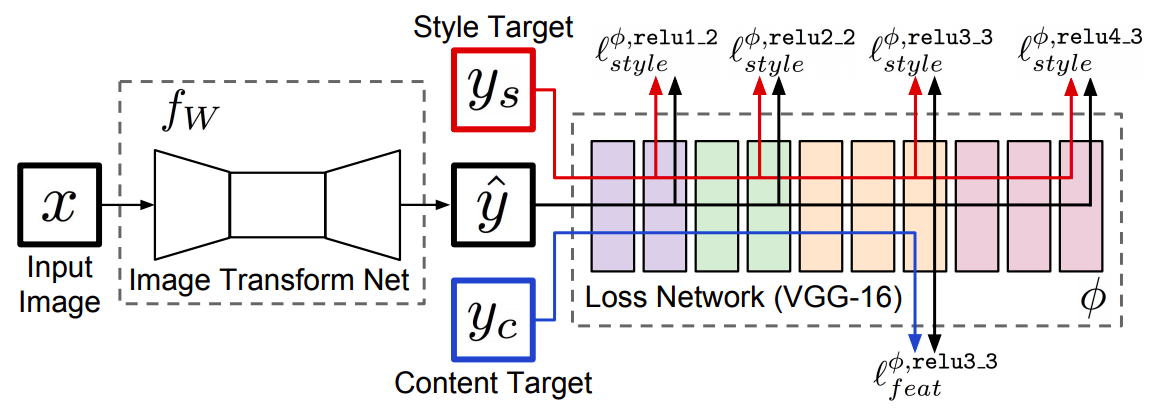
风格图片是固定的,而内容图片是可变的输入,因此以上模型用于将任意图片快速转换为指定风格的图片
- 转换网络:参数需要训练,将内容图片转换成迁移图片
- 损失网络:计算迁移图片和风格图片之间的风格损失,以及迁移图片和原始内容图片之间的内容损失
经过训练后,转换网络所生成的迁移图片,在内容上和输入的内容图片相似,在风格上和指定的风格图片相似
进行推断时,仅使用转换网络,输入内容图片,即可得到对应的迁移图片
如果有多个风格图片,对每个风格分别训练一个模型即可
实现
基于以下两个项目进行修改,github.com/lengstrom/f…、github.com/hzy46/fast-…
依然通过之前用过的imagenet-vgg-verydeep-19.mat计算内容损失函数和风格损失函数
需要一些图片作为输入的内容图片,对图片具体内容没有任何要求,也不需要任何标注,这里选择使用MSCOCO数据集的train2014部分,cocodataset.org/#download,共82612张图片
加载库
# -*- coding: utf-8 -*-
import tensorflow as tf
import numpy as np
import cv2
from imageio import imread, imsave
import scipy.io
import os
import glob
from tqdm import tqdm
import matplotlib.pyplot as plt
%matplotlib inline
查看风格图片,共10张
style_images = glob.glob('styles/*.jpg')
print(style_images)
加载内容图片,去掉黑白图片,处理成指定大小,暂时不进行归一化,像素值范围为0至255之间
def resize_and_crop(image, image_size):
h = image.shape[0]
w = image.shape[1]
if h > w:
image = image[h // 2 - w // 2: h // 2 + w // 2, :, :]
else:
image = image[:, w // 2 - h // 2: w // 2 + h // 2, :]
image = cv2.resize(image, (image_size, image_size))
return image
X_data = []
image_size = 256
paths = glob.glob('train2014/*.jpg')
for i in tqdm(range(len(paths))):
path = paths[i]
image = imread(path)
if len(image.shape) < 3:
continue
X_data.append(resize_and_crop(image, image_size))
X_data = np.array(X_data)
print(X_data.shape)
加载vgg19模型,并定义一个函数,对于给定的输入,返回vgg19各个层的输出值,就像在GAN中那样,通过variable_scope重用实现网络的重用
vgg = scipy.io.loadmat('imagenet-vgg-verydeep-19.mat')
vgg_layers = vgg['layers']
def vgg_endpoints(inputs, reuse=None):
with tf.variable_scope('endpoints', reuse=reuse):
def _weights(layer, expected_layer_name):
W = vgg_layers[0][layer][0][0][2][0][0]
b = vgg_layers[0][layer][0][0][2][0][1]
layer_name = vgg_layers[0][layer][0][0][0][0]
assert layer_name == expected_layer_name
return W, b
def _conv2d_relu(prev_layer, layer, layer_name):
W, b = _weights(layer, layer_name)
W = tf.constant(W)
b = tf.constant(np.reshape(b, (b.size)))
return tf.nn.relu(tf.nn.conv2d(prev_layer, filter=W, strides=[1, 1, 1, 1], padding='SAME') + b)
def _avgpool(prev_layer):
return tf.nn.avg_pool(prev_layer, ksize=[1, 2, 2, 1], strides=[1, 2, 2, 1], padding='SAME')
graph = {}
graph['conv1_1'] = _conv2d_relu(inputs, 0, 'conv1_1')
graph['conv1_2'] = _conv2d_relu(graph['conv1_1'], 2, 'conv1_2')
graph['avgpool1'] = _avgpool(graph['conv1_2'])
graph['conv2_1'] = _conv2d_relu(graph['avgpool1'], 5, 'conv2_1')
graph['conv2_2'] = _conv2d_relu(graph['conv2_1'], 7, 'conv2_2')
graph['avgpool2'] = _avgpool(graph['conv2_2'])
graph['conv3_1'] = _conv2d_relu(graph['avgpool2'], 10, 'conv3_1')
graph['conv3_2'] = _conv2d_relu(graph['conv3_1'], 12, 'conv3_2')
graph['conv3_3'] = _conv2d_relu(graph['conv3_2'], 14, 'conv3_3')
graph['conv3_4'] = _conv2d_relu(graph['conv3_3'], 16, 'conv3_4')
graph['avgpool3'] = _avgpool(graph['conv3_4'])
graph['conv4_1'] = _conv2d_relu(graph['avgpool3'], 19, 'conv4_1')
graph['conv4_2'] = _conv2d_relu(graph['conv4_1'], 21, 'conv4_2')
graph['conv4_3'] = _conv2d_relu(graph['conv4_2'], 23, 'conv4_3')
graph['conv4_4'] = _conv2d_relu(graph['conv4_3'], 25, 'conv4_4')
graph['avgpool4'] = _avgpool(graph['conv4_4'])
graph['conv5_1'] = _conv2d_relu(graph['avgpool4'], 28, 'conv5_1')
graph['conv5_2'] = _conv2d_relu(graph['conv5_1'], 30, 'conv5_2')
graph['conv5_3'] = _conv2d_relu(graph['conv5_2'], 32, 'conv5_3')
graph['conv5_4'] = _conv2d_relu(graph['conv5_3'], 34, 'conv5_4')
graph['avgpool5'] = _avgpool(graph['conv5_4'])
return graph
选择一张风格图,减去通道颜色均值后,得到风格图片在vgg19各个层的输出值,计算四个风格层对应的Gram矩阵
style_index = 1
X_style_data = resize_and_crop(imread(style_images[style_index]), image_size)
X_style_data = np.expand_dims(X_style_data, 0)
print(X_style_data.shape)
MEAN_VALUES = np.array([123.68, 116.779, 103.939]).reshape((1, 1, 1, 3))
X_style = tf.placeholder(dtype=tf.float32, shape=X_style_data.shape, name='X_style')
style_endpoints = vgg_endpoints(X_style - MEAN_VALUES)
STYLE_LAYERS = ['conv1_2', 'conv2_2', 'conv3_3', 'conv4_3']
style_features = {}
sess = tf.Session()
for layer_name in STYLE_LAYERS:
features = sess.run(style_endpoints[layer_name], feed_dict={X_style: X_style_data})
features = np.reshape(features, (-1, features.shape[3]))
gram = np.matmul(features.T, features) / features.size
style_features[layer_name] = gram
定义转换网络,典型的卷积、残差、逆卷积结构,内容图片输入之前也需要减去通道颜色均值
batch_size = 4
X = tf.placeholder(dtype=tf.float32, shape=[None, None, None, 3], name='X')
k_initializer = tf.truncated_normal_initializer(0, 0.1)
def relu(x):
return tf.nn.relu(x)
def conv2d(inputs, filters, kernel_size, strides):
p = int(kernel_size / 2)
h0 = tf.pad(inputs, [[0, 0], [p, p], [p, p], [0, 0]], mode='reflect')
return tf.layers.conv2d(inputs=h0, filters=filters, kernel_size=kernel_size, strides=strides, padding='valid', kernel_initializer=k_initializer)
def deconv2d(inputs, filters, kernel_size, strides):
shape = tf.shape(inputs)
height, width = shape[1], shape[2]
h0 = tf.image.resize_images(inputs, [height * strides * 2, width * strides * 2], tf.image.ResizeMethod.NEAREST_NEIGHBOR)
return conv2d(h0, filters, kernel_size, strides)
def instance_norm(inputs):
return tf.contrib.layers.instance_norm(inputs)
def residual(inputs, filters, kernel_size):
h0 = relu(conv2d(inputs, filters, kernel_size, 1))
h0 = conv2d(h0, filters, kernel_size, 1)
return tf.add(inputs, h0)
with tf.variable_scope('transformer', reuse=None):
h0 = tf.pad(X - MEAN_VALUES, [[0, 0], [10, 10], [10, 10], [0, 0]], mode='reflect')
h0 = relu(instance_norm(conv2d(h0, 32, 9, 1)))
h0 = relu(instance_norm(conv2d(h0, 64, 3, 2)))
h0 = relu(instance_norm(conv2d(h0, 128, 3, 2)))
for i in range(5):
h0 = residual(h0, 128, 3)
h0 = relu(instance_norm(deconv2d(h0, 64, 3, 2)))
h0 = relu(instance_norm(deconv2d(h0, 32, 3, 2)))
h0 = tf.nn.tanh(instance_norm(conv2d(h0, 3, 9, 1)))
h0 = (h0 + 1) / 2 * 255.
shape = tf.shape(h0)
g = tf.slice(h0, [0, 10, 10, 0], [-1, shape[1] - 20, shape[2] - 20, -1], name='g')
将转换网络的输出即迁移图片,以及原始内容图片都输入到vgg19,得到各自对应层的输出,计算内容损失函数
CONTENT_LAYER = 'conv3_3'
content_endpoints = vgg_endpoints(X - MEAN_VALUES, True)
g_endpoints = vgg_endpoints(g - MEAN_VALUES, True)
def get_content_loss(endpoints_x, endpoints_y, layer_name):
x = endpoints_x[layer_name]
y = endpoints_y[layer_name]
return 2 * tf.nn.l2_loss(x - y) / tf.to_float(tf.size(x))
content_loss = get_content_loss(content_endpoints, g_endpoints, CONTENT_LAYER)
根据迁移图片和风格图片在指定风格层的输出,计算风格损失函数
style_loss = []
for layer_name in STYLE_LAYERS:
layer = g_endpoints[layer_name]
shape = tf.shape(layer)
bs, height, width, channel = shape[0], shape[1], shape[2], shape[3]
features = tf.reshape(layer, (bs, height * width, channel))
gram = tf.matmul(tf.transpose(features, (0, 2, 1)), features) / tf.to_float(height * width * channel)
style_gram = style_features[layer_name]
style_loss.append(2 * tf.nn.l2_loss(gram - style_gram) / tf.to_float(tf.size(layer)))
style_loss = tf.reduce_sum(style_loss)
计算全变差正则,得到总的损失函数
def get_total_variation_loss(inputs):
h = inputs[:, :-1, :, :] - inputs[:, 1:, :, :]
w = inputs[:, :, :-1, :] - inputs[:, :, 1:, :]
return tf.nn.l2_loss(h) / tf.to_float(tf.size(h)) + tf.nn.l2_loss(w) / tf.to_float(tf.size(w))
total_variation_loss = get_total_variation_loss(g)
content_weight = 1
style_weight = 250
total_variation_weight = 0.01
loss = content_weight * content_loss + style_weight * style_loss + total_variation_weight * total_variation_loss
定义优化器,通过调整转换网络中的参数降低总损失
vars_t = [var for var in tf.trainable_variables() if var.name.startswith('transformer')]
optimizer = tf.train.AdamOptimizer(learning_rate=0.001).minimize(loss, var_list=vars_t)
训练模型,每轮训练结束后,用一张测试图片进行测试,并且将一些tensor的值写入events文件,便于使用tensorboard查看
style_name = style_images[style_index]
style_name = style_name[style_name.find('/') + 1:].rstrip('.jpg')
OUTPUT_DIR = 'samples_%s' % style_name
if not os.path.exists(OUTPUT_DIR):
os.mkdir(OUTPUT_DIR)
tf.summary.scalar('losses/content_loss', content_loss)
tf.summary.scalar('losses/style_loss', style_loss)
tf.summary.scalar('losses/total_variation_loss', total_variation_loss)
tf.summary.scalar('losses/loss', loss)
tf.summary.scalar('weighted_losses/weighted_content_loss', content_weight * content_loss)
tf.summary.scalar('weighted_losses/weighted_style_loss', style_weight * style_loss)
tf.summary.scalar('weighted_losses/weighted_total_variation_loss', total_variation_weight * total_variation_loss)
tf.summary.image('transformed', g)
tf.summary.image('origin', X)
summary = tf.summary.merge_all()
writer = tf.summary.FileWriter(OUTPUT_DIR)
sess.run(tf.global_variables_initializer())
losses = []
epochs = 2
X_sample = imread('sjtu.jpg')
h_sample = X_sample.shape[0]
w_sample = X_sample.shape[1]
for e in range(epochs):
data_index = np.arange(X_data.shape[0])
np.random.shuffle(data_index)
X_data = X_data[data_index]
for i in tqdm(range(X_data.shape[0] // batch_size)):
X_batch = X_data[i * batch_size: i * batch_size + batch_size]
ls_, _ = sess.run([loss, optimizer], feed_dict={X: X_batch})
losses.append(ls_)
if i > 0 and i % 20 == 0:
writer.add_summary(sess.run(summary, feed_dict={X: X_batch}), e * X_data.shape[0] // batch_size + i)
writer.flush()
print('Epoch %d Loss %f' % (e, np.mean(losses)))
losses = []
gen_img = sess.run(g, feed_dict={X: [X_sample]})[0]
gen_img = np.clip(gen_img, 0, 255)
result = np.zeros((h_sample, w_sample * 2, 3))
result[:, :w_sample, :] = X_sample / 255.
result[:, w_sample:, :] = gen_img[:h_sample, :w_sample, :] / 255.
plt.axis('off')
plt.imshow(result)
plt.show()
imsave(os.path.join(OUTPUT_DIR, 'sample_%d.jpg' % e), result)
保存模型
saver = tf.train.Saver()
saver.save(sess, os.path.join(OUTPUT_DIR, 'fast_style_transfer'))
测试图片依旧是之前用过的交大庙门
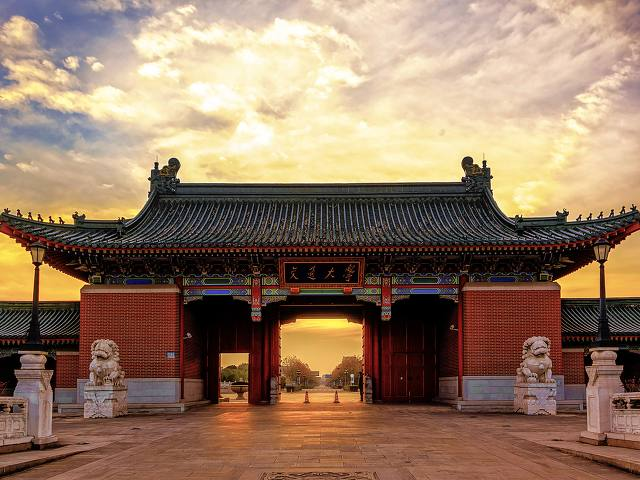
风格迁移结果
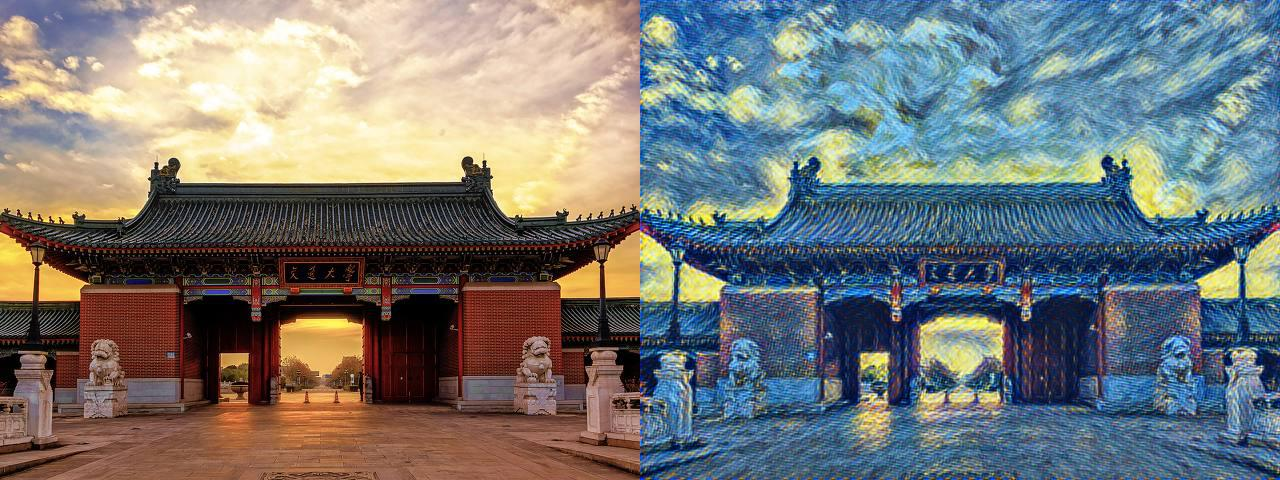
训练过程中可以使用tensorboard查看训练过程
tensorboard --logdir=samples_starry
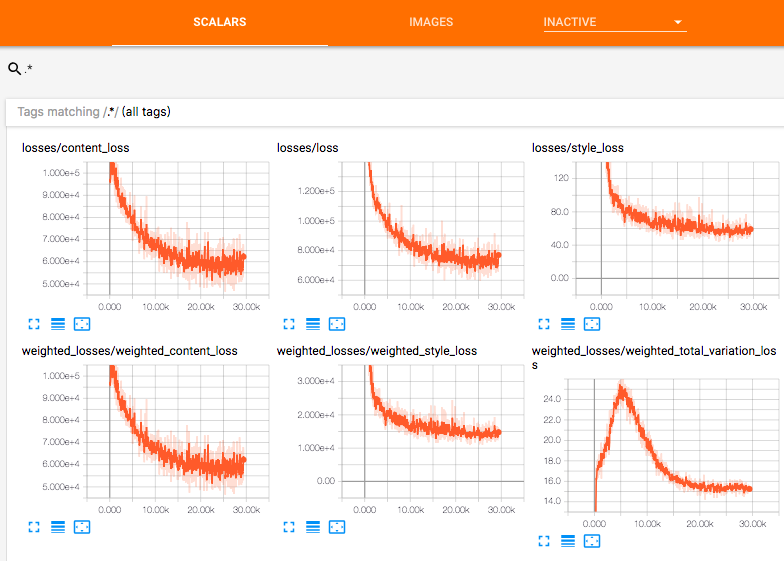
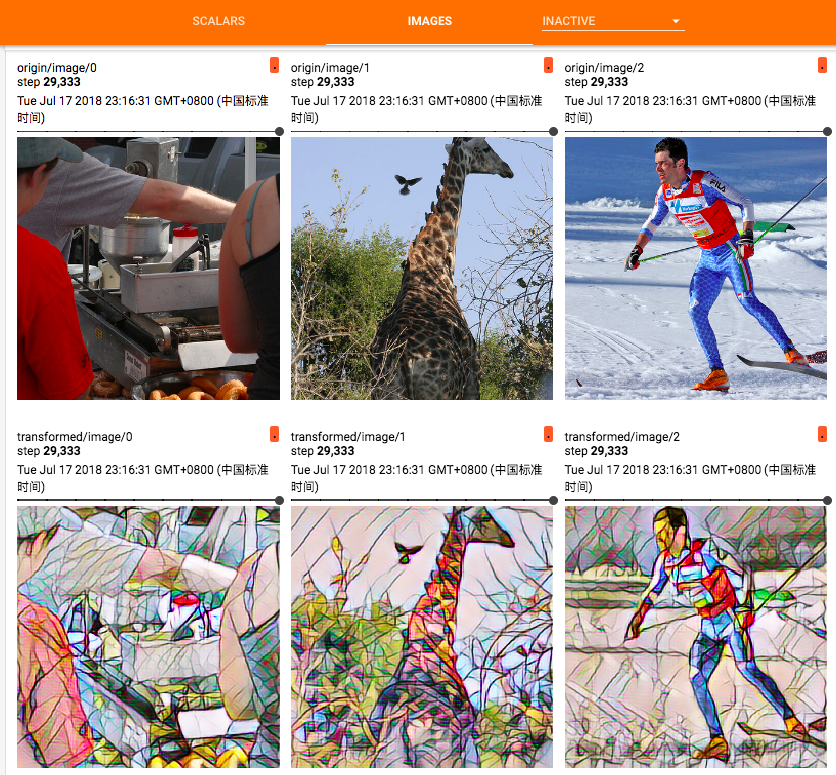
在单机上使用以下代码即可快速完成风格迁移,在CPU上也只需要10秒左右
# -*- coding: utf-8 -*-
import tensorflow as tf
import numpy as np
from imageio import imread, imsave
import os
import time
def the_current_time():
print(time.strftime("%Y-%m-%d %H:%M:%S", time.localtime(int(time.time()))))
style = 'wave'
model = 'samples_%s' % style
content_image = 'sjtu.jpg'
result_image = 'sjtu_%s.jpg' % style
X_image = imread(content_image)
sess = tf.Session()
sess.run(tf.global_variables_initializer())
saver = tf.train.import_meta_graph(os.path.join(model, 'fast_style_transfer.meta'))
saver.restore(sess, tf.train.latest_checkpoint(model))
graph = tf.get_default_graph()
X = graph.get_tensor_by_name('X:0')
g = graph.get_tensor_by_name('transformer/g:0')
the_current_time()
gen_img = sess.run(g, feed_dict={X: [X_image]})[0]
gen_img = np.clip(gen_img, 0, 255) / 255.
imsave(result_image, gen_img)
the_current_time()
对于其他风格图片,用相同方法训练对应模型即可

参考
- Perceptual Losses for Real-Time Style Transfer and Super-Resolution:arxiv.org/abs/1603.08…
- Fast Style Transfer in TensorFlow:github.com/lengstrom/f…
- A Tensorflow Implementation for Fast Neural Style:github.com/hzy46/fast-…